Recruiters often face a unique challenge: standing out in a sea of job postings and career opportunities. With so many employment options available to today’s job seekers, simply listing openings on a website isn’t enough. This is where SEO comes into play.
By optimizing your recruitment website, you can boost visibility on search engines, attract better-qualified candidates, and enhance your employer brand. In this guide, we’ll explore the fundamental concepts of recruitment SEO, explain why it matters, and show you how to harness its power to secure top talent.
Introduction to Recruitment SEO

SEO for recruitment involves enhancing your job listings, career pages, and overall recruitment website so they appear prominently on search engine results pages (SERPs) for relevant candidate searches. Traditional SEO focuses on driving any type of web traffic, but recruitment SEO hones in on attracting potential applicants looking for roles in specific industries, locations, or skill sets.
Recruitment SEO considers how job seekers navigate the web, from searching for positions using specific role-based keywords (e.g., “Senior Marketing Manager in New York”) to browsing company culture information. By ensuring your site is well-optimized, you stand out in these search results, compelling qualified applicants to learn more and, ultimately, apply.
Key principles include:
- Keyword Optimization: Using terms candidates are likely to search for, such as job titles, specialties, and location-based phrases.
- High-Quality Content: Providing detailed, engaging job descriptions and culture insights that resonate with potential applicants.
- Technical Excellence: Ensuring fast site speed, mobile-friendly pages, and proper indexing so job seekers can find your listings quickly.
- User Experience (UX): Structuring your site in a way that makes it easy for visitors to navigate, learn about your brand, and apply for positions.
How Recruitment SEO Differs from General SEO
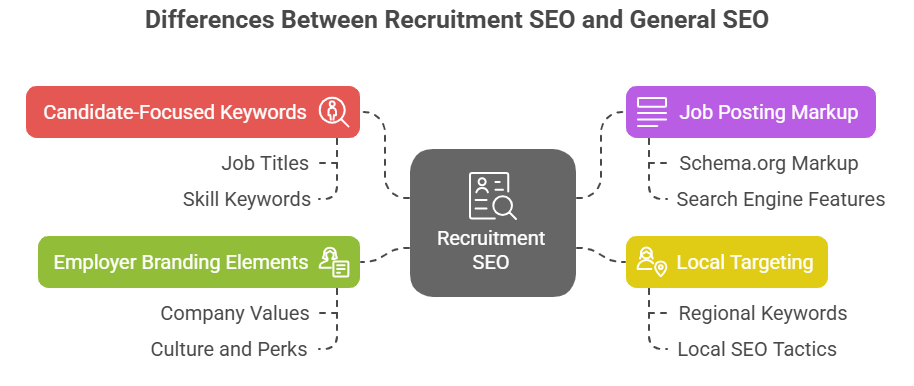
While general SEO may focus on product keywords, backlinks, and wide-ranging topics, recruitment SEO zeroes in on career-related searches and talent attraction. Here are a few core differences:
- Candidate-Focused Keywords: Instead of broad commercial or informational phrases, recruitment sites use specific job or skill-related keywords like “remote software engineer jobs” or “entry-level HR assistant.”
- Job Posting Markup: Incorporating structured data (like Schema.org’s JobPosting) tells search engines important details (job title, salary range, location), helping listings appear in specialized job search features on Google.
- Local Targeting: Many openings are tied to a specific region, so local SEO tacticssuch as optimizing for “Finance jobs in Los Angeles”help reach nearby talent.
- Employer Branding Elements: Recruitment SEO addresses brand perception. Content around company values, culture, and perks can engage candidates on a deeper level than typical product-focused SEO.
Why Is SEO Important in Recruitment?
- Increased Visibility: A well-optimized recruitment website ranks higher in search results, putting job listings where top candidates are most likely to see them.
- Cost-Effectiveness: By organically attracting job seekers, you can reduce reliance on costly advertising platforms or paid job boards.
- Competitive Advantage: SEO can help you stand out in crowded job markets, especially if you’re competing against larger or more established brands.
- Sustainable Pipeline: High-quality, organic traffic translates to a more consistent flow of qualified applicants over time.
How SEO Helps Attract Qualified Candidates
When people search for roles online, they typically use specific queries, like “Data Scientist jobs in Chicago” or “entry-level graphic design positions.” An SEO-optimized site ensures these searches lead to your postings. Once candidates arrive, clear and compelling information about the role, company culture, and growth opportunities encourages them to apply. Because you’re targeting more precise keywords, the applicants who find you are more likely to be a good match for the position, leading to higher application-to-hire ratios.
The Impact on Employer Branding
Your recruitment website is an extension of your brand. A strong SEO strategy shines a spotlight on not only your open roles but also your work environment, values, and success stories. As your pages consistently appear in top search results, potential employees associate your organization with authority and credibility. In turn, this bolsters your reputation as an employer of choice, drawing even more exceptional candidates in the long run.
On-Page vs. Off-Page vs. Technical SEO
Every recruitment website relies on three core SEO pillarson-page, off-page, and technicalto rank highly in search results and attract ideal candidates. Each element plays a unique role in shaping visibility and user experience, which is vital when you’re competing for top talent. Below is a table outlining the key distinctions, along with how they collectively support recruitment efforts.
| SEO Component | Focus | Key Tactics | How It Supports Recruitment |
|---|---|---|---|
| On-Page SEO | Optimizing visible content | – Craft keyword-rich job titles and descriptions
– Use clear, concise meta tags – Include engaging content about company culture – Leverage internal links to relevant openings and blog posts |
– Attracts job seekers using precise search terms
– Highlights employer brand and culture – Increases relevance to search engine queries |
| Off-Page SEO | Building authority and credibility | – Earn backlinks from industry sites, job boards, and professional networks
– Encourage social sharing of job openings – Engage with influencers or niche publications |
– Boosts your site’s reputation in the eyes of search engines
– Expands reach to passive and active candidates – Strengthens employer branding through external endorsements |
| Technical SEO | Ensuring site accessibility | – Improve page load times
– Implement structured data (e.g., JobPosting schema) – Ensure mobile-friendliness – Fix broken links and use proper redirects |
– Enhances candidate user experience and trust
– Helps your listings appear in specialized job search results – Maintains site credibility and ranking stability |
Importance of Integrating All Three for a Holistic Strategy
When these three pillars work together, they deliver a recruitment website that’s both visible and compelling. On-page SEO ensures job seekers find relevant content; off-page SEO elevates your brand’s reputation and reaches wider audiences; and technical SEO ensures every visitorhuman or search engine crawlercan navigate your site effectively.
By balancing all three, you’ll enhance both the quantity and quality of candidates who discover and engage with your recruitment pages.
Understanding How Google Ranks Recruitment Content
Google aims to deliver the most relevant and trustworthy information to job seekers. When your recruitment website provides well-structured job listings, credible company insights, and a solid user experience, search engines are more likely to reward it with higher visibility.
SEO for recruitment companies involves crafting content that speaks directly to potential applicants while meeting Google’s technical and quality guidelines. By focusing on key ranking factors such as relevance, authority, and user experience, you set the stage for better applicant engagement and higher SERP positions.
Key Ranking Factors for Recruitment Pages
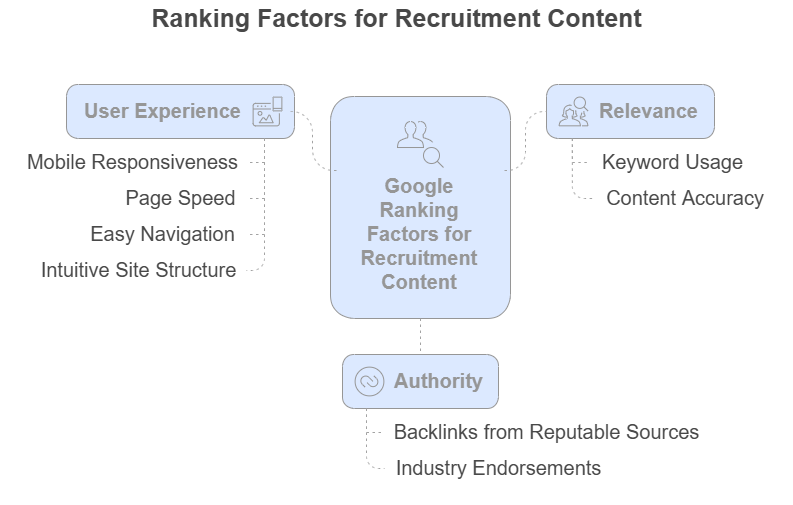
Relevance, Authority, and User Experience
Search engines evaluate web pages by looking at how closely content matches a user’s search. In recruitment, this often means including precise keywords (e.g., “Software Engineer Jobs in Austin”) and ensuring the page accurately answers the candidate’s query.
Authority relates to the credibility of your site, often boosted by backlinks from reputable industry sources. When other respected sites reference your vacancies or recruitment insights, it signals trustworthiness.
User experience underpins all of this. If your site is cumbersome or filled with low-value content, visitors will leave quicklysomething Google interprets as a sign of poor quality.
E-A-T (Expertise, Authoritativeness, Trustworthiness) in the Hiring Context
Though E-A-T originates from Google’s guidelines for quality content, it applies equally to recruitment. Expertise involves showing you fully understand the job market, roles, and requirements. Authoritativeness hinges on how your site is perceived by candidates and industry peers. Trustworthiness emerges from transparent information, including company values, clear job descriptions, and secure application processes.
When you demonstrate expertise in niche hiring topics, have endorsements from credible industry partners, and maintain consistent brand ethics, Google is more inclined to rank your recruitment pages higher.
The Role of User Experience (UX)
Mobile Responsiveness and Page Speed
Job seekers frequently use their phones to search for positions, so a mobile-friendly design and fast loading times are non-negotiable. A site that’s easy to browse on smaller screens engages users longer, boosting rankings. Compress images, optimize code, and use fast hosting services to keep page speed at optimal levels.
Website Navigation for Job Seekers
Candidates often look for clear, simple menus that guide them to open roles, company culture pages, or FAQs. A straightforward menu structure encourages exploration, helping users find relevant listings quickly. Internal links between job descriptions and related posts further streamline the candidate experience, reducing frustration and leading to more completed applications.
Importance of Intuitive Site Structure
An intuitive site structure supports both user experience and SEO for recruitment companies. Logical categoriesfor instance, grouping roles by department or locationhelp Google’s bots crawl your site effectively, ensuring all listings get indexed. Clear labeling of pages, well-organized URLs, and easy-to-follow navigation all contribute to higher visibility in search results.
By maintaining a balance of relevant content, authoritative signals, and strong user experience, your recruitment site can stand out in a competitive digital hiring landscape.
Building a Recruitment SEO Strategy
A robust strategy is essential when it comes to SEO. By outlining clear objectives, spotlighting employer branding, and truly understanding your target audience, you create a blueprint that attracts qualified talent directly to your website.
Focusing on measurable goals and aligning them with both SEO and HR priorities ensures that every optimization step contributes to meaningful hiring outcomes.
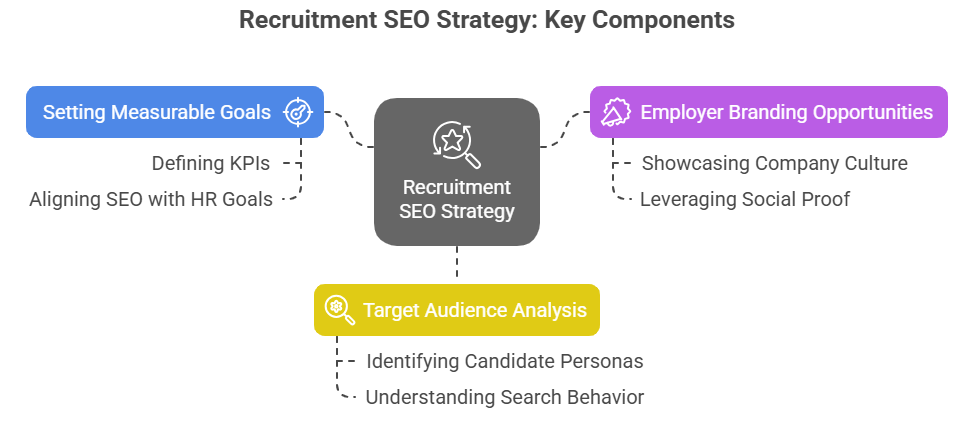
Setting Measurable Goals and Objectives
Defining your goals is the first step toward a streamlined recruitment SEO plan. When you know exactly what you want to achieve, it’s easier to track progress and pivot if needed.
Defining KPIs (e.g., applications, conversions, time to fill)
Different recruitment agencies prioritize different metrics. Some focus on the number of applications received each month, while others keep an eye on how many quality candidates convert into interviews or hires.
Time to fill is another popular KPI. This measures how quickly you can move a vacancy from posting to job offer, which can spotlight bottlenecks in your hiring process.
Aligning SEO Goals with Recruitment and HR Goals
SEO-driven objectives should mesh seamlessly with broader recruiting targets. For instance, if your HR team’s priority is to hire software engineers within two weeks, your SEO focus might be to rank higher for key phrases like “remote Python developer jobs” or “junior web developer openings.”
By syncing your SEO efforts with hiring timelines and departmental demands, you ensure that all stakeholders benefit and that resources are allocated effectively.
Employer Branding Opportunities
Employer branding sets you apart from the pack and attracts like-minded professionals who thrive in your culture. Incorporating elements of brand identity into your SEO activities can drive genuine engagement and fortify your online presence.
Showcasing Company Culture in SEO-Friendly Ways
Candidates often want a glimpse into the daily work environment before applying. Highlight behind-the-scenes content, employee spotlights, and stories of professional growth.
Opt for keyword-rich titles and descriptions that reflect your organization’s values and perks. This ensures search enginesand prospective applicantsrecognize the unique experiences your agency offers.
Leveraging Social Proof (Testimonials, Reviews, Glassdoor Ratings)
Job seekers frequently research companies by reading employee reviews, testimonials, and Glassdoor ratings. Including these endorsements on relevant pages boosts credibility while also improving keyword relevance.
Embed short quotes from satisfied candidates or employees, and use schema markup where possible. When people feel they can trust your brand, they’re more likely to apply and recommend your roles to peers.
Target Audience Analysis
Knowing who you’re trying to attract is fundamental to effective SEO for recruitment agencies. By digging into candidate personas and search patterns, you can serve up the right content at the right time.
Identifying Candidate Personas
Begin by defining the ideal skills, experience levels, and motivations of the talent you seek. For instance, a persona might be a mid-level graphic designer who values flexible work hours and career development opportunities.
Use these profiles to inform your keyword choices and content strategy. Tailoring job descriptions and culture pages to specific personas helps you resonate with the candidates most likely to succeed in each role.
Understanding Candidate Search Behavior
Candidates often search for roles using phrases like “entry-level marketing jobs in San Francisco” or “creative positions at growth-stage startups.” Analyzing these patterns helps you decide which terms to include in titles, headings, and meta descriptions.
It’s also vital to consider search intent. Someone looking for “how to get a data analyst job” might be earlier in their job search process, whereas someone typing “data analyst position at [Company Name]” is likely ready to apply. Catering to these varying stages ensures your content meets a range of user needs.
Keyword Research for Recruiters
Keyword research is an essential strategy for recruiters aiming to enhance the visibility of their websites, attract quality candidates, and fill positions more efficiently. By targeting the right keywords, recruitment websites can rank higher on search engines, making it easier for job seekers and employers to find them.
Understanding the nuances of keyword research for the recruitment industry involves more than just listing job titles. It requires a strategic approach to identifying terms that resonate with both active job seekers and passive candidates.
Creating a Keyword List
Brainstorming Relevant Job Titles, Skills, and Industry Terms
Start by identifying the core job titles, skills, and industry-specific terms relevant to your recruitment niche. Consider:
- Job Titles: Think beyond generic titles like “Marketing Manager” to include variations such as “Digital Marketing Lead,” “Content Marketing Specialist,” or “Growth Marketing Strategist.”
- Skills: Highlight essential skills like “SEO optimization,” “data analysis,” “Java programming,” or “project management.”
- Industry Terms: Include industry-specific jargon and acronyms that candidates and employers commonly use, such as “SaaS sales,” “Agile methodology,” or “UI/UX design.”
Using brainstorming sessions with your team can uncover hidden keyword opportunities that resonate with both candidates and hiring managers.
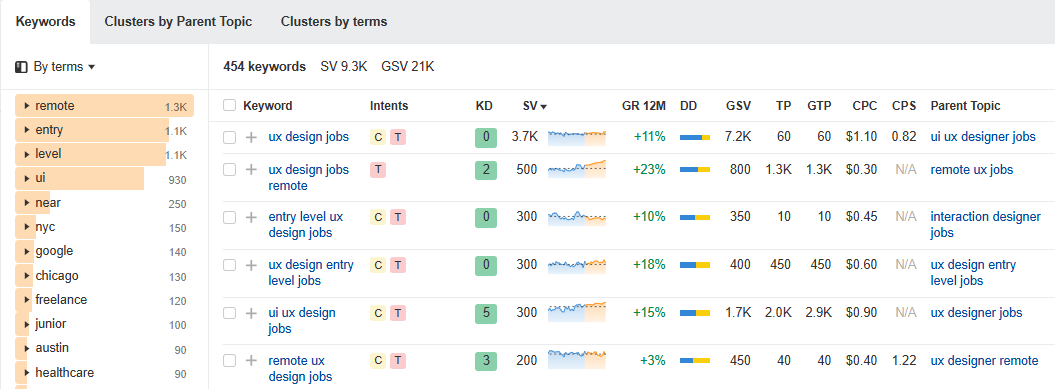
UX design jobs related keywords ideas
Addressing Different Stages of the Candidate’s Journey (Awareness, Consideration, Conversion)
Effective keyword research considers the candidate’s journey:
- Awareness Stage: Target broad queries like “best tech jobs in 2025” or “careers in digital marketing.” These attract individuals exploring career options.
- Consideration Stage: Focus on specific job-related searches such as “remote graphic designer roles” or “entry-level data analyst jobs.”
- Conversion Stage: Optimize for action-driven keywords like “apply for project manager job,” “submit resume for finance roles,” or “recruitment agencies for IT jobs.”
By addressing each stage, you ensure your content meets the needs of candidates at different points in their job search.
Analyzing Other Websites in Your Niche
Competitor analysis is invaluable for keyword discovery. Identify top-performing recruitment websites within your niche and analyze:
- Their target keywords: Use SEO tools like SEMrush or Ahrefs to uncover the keywords driving their traffic.
- Content structure: Note how they optimize job listings, blog content, and landing pages.
- Gaps: Look for keyword opportunities they might have missed, allowing you to capture untapped search traffic.
This approach helps you stay competitive and discover keywords you may not have considered.
Researching Search Volumes and Keyword Difficulty
Tools (Google Keyword Planner, SEMrush, etc.)
Leverage keyword research tools to validate your keyword list:
- Google Keyword Planner: Ideal for identifying search volume trends and keyword competition.
- SEMrush: Provides comprehensive data on keyword difficulty, search volume, and competitor analysis.
- Ahrefs: Excellent for keyword gap analysis and discovering long-tail keyword opportunities.
- Ubersuggest: Offers user-friendly insights, particularly useful for smaller recruitment firms.
These tools help you prioritize keywords based on data-driven insights rather than assumptions.
Balancing Short-Tail vs. Long-Tail Keywords
Striking the right balance between short-tail and long-tail keywords is crucial:
- Short-Tail Keywords: Broad terms like “marketing jobs” or “software engineer” attract high search volumes but are highly competitive.
- Long-Tail Keywords: More specific phrases like “remote content marketing jobs for startups” or “entry-level software developer jobs in New York” have lower competition and higher conversion rates.
For recruitment websites, long-tail keywords often yield better results because they attract candidates with clear intent. Incorporate both types into your strategy to maximize reach and relevance.
Location-Based Keywords
Identifying Local Search Intent (City, Region, Remote Roles)
Local search intent is critical for recruitment websites because job seekers often include specific locations in their search queries. This could range from city-specific searches like “marketing jobs in Chicago” to broader regional searches such as “finance roles in the Midwest.”
Additionally, with the growing trend of remote work, keywords like “remote graphic design jobs” or “work-from-home software engineering roles” are gaining popularity. Understanding these variations helps you target candidates who are actively searching for jobs in specific geographic areas or flexible work environments.
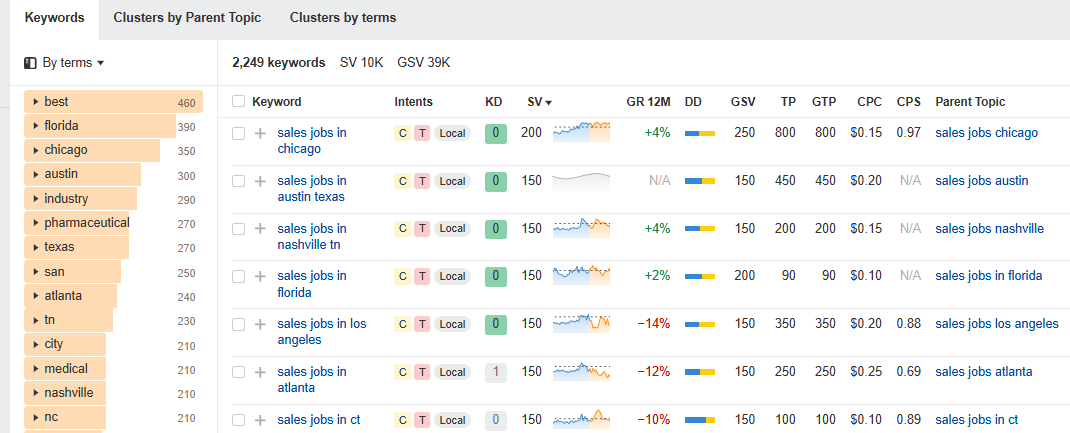
Location-based keyword ideas for Sales Jobs
Leveraging Location-Based Job Queries
To effectively capture local search traffic, incorporate location-based keywords throughout your site, including:
- Job Listings: Include city, region, or remote details in job titles and descriptions. For example, instead of just “Sales Manager,” use “Sales Manager – New York City” or “Remote Sales Manager.”
- Landing Pages: Create dedicated landing pages for major cities or regions where you frequently recruit. This could be as specific as “Healthcare Jobs in Dallas” or “Tech Roles in Berlin.”
- Metadata and URLs: Optimize page titles, meta descriptions, and URL slugs with location-based terms to improve search engine visibility. For example, www.example.com/tech-jobs-boston.
By structuring your content around these location-specific queries, you increase the chances of appearing in relevant local search results.
Practice Area and Niche Keywords
Focusing on Specialized Roles or Industries (Tech, Healthcare, Finance, etc.)
Recruitment websites often perform better when they focus on niche markets. Instead of competing broadly for generic terms like “IT jobs,” narrow your focus to specialized industries such as:
- Tech: Keywords like “full-stack developer jobs,” “cybersecurity analyst roles,” or “AI engineer positions.”
- Healthcare: Focus on terms like “registered nurse jobs,” “clinical research coordinator roles,” or “physical therapist positions.”
- Finance: Target keywords such as “investment banking analyst jobs,” “accounting careers in Chicago,” or “tax consultant openings.”
Specializing helps attract highly qualified candidates who are searching for roles within their specific fields.
Highlighting Sub-Niches for More Precise Targeting
Drilling down even further into sub-niches can improve your search rankings and attract the right talent. For example:
- Tech Sub-Niches: “React developer remote jobs,” “DevOps engineer freelance roles.”
- Healthcare Sub-Niches: “Pediatric nurse vacancies,” “oncology research associate jobs.”
- Finance Sub-Niches: “Forensic accounting positions,” “hedge fund analyst careers.”
Focusing on sub-niches not only reduces competition but also connects your recruitment website with candidates who have specialized skills, increasing conversion rates.
Transactional vs. Informational Keywords
Aligning Page Types with Keyword Intent (Job Listings vs. Blog Posts)
Understanding the difference between transactional and informational keywords ensures that you’re meeting user intent effectively:
- Transactional Keywords: These indicate that a user is ready to take action. Examples include “apply for digital marketing job,” “submit resume for data analyst role,” or “entry-level accounting jobs near me.” These keywords are best suited for job listing pages and application forms where users can immediately engage with your offerings.
- Informational Keywords: These are used when users are looking for information rather than taking direct action. Examples include “how to prepare for a tech job interview,” “best skills for a project manager,” or “career growth in digital marketing.” Informational keywords are perfect for blog posts, guides, and resource pages that educate and engage potential candidates.
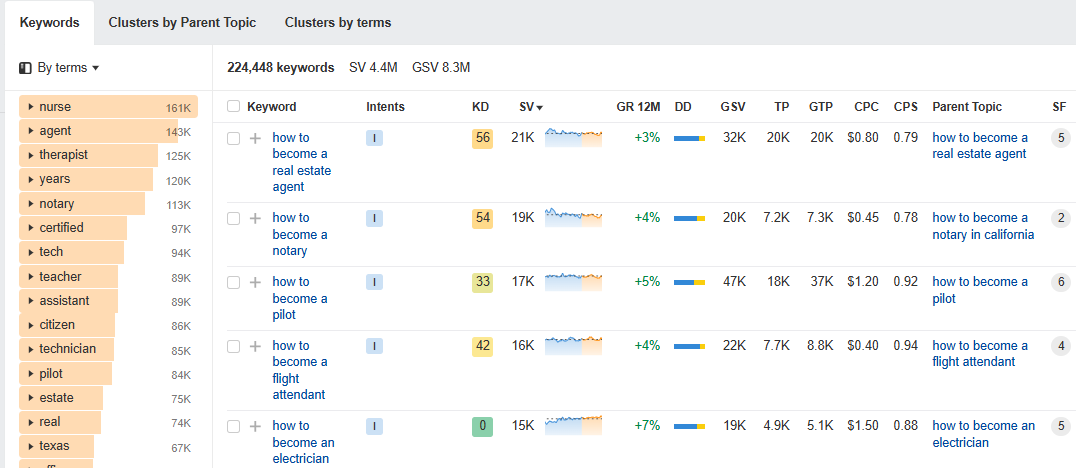
Job-related Informational Keywords
By aligning content types with keyword intent, you can guide users more effectively through the candidate journey.
Keyword Cannibalization & Confusion
Common Pitfalls and How to Consolidate Competing Pages
Keyword cannibalization occurs when multiple pages on your website target the same or very similar keywords. This can confuse search engines, leading to lower rankings because they don’t know which page to prioritize.
Common pitfalls include:
- Having multiple job listings or blog posts optimized for the same job title, like “Marketing Manager Jobs” appearing on several pages.
- Creating separate pages for every minor keyword variation without adding unique value to each.
How to fix it:
- Consolidate Content: If two pages are competing for the same keyword, merge them into a single, comprehensive page that provides more value.
- Differentiate Keyword Targets: Ensure each page focuses on a distinct keyword or intent. For example, one page can target “remote project manager jobs,” while another focuses on “freelance project management opportunities.”
- Internal Linking: Use strategic internal links to guide users and search engines to the most authoritative pages for specific keywords.
Addressing keyword cannibalization not only improves SEO performance but also enhances the user experience by reducing redundant content.
On-Page SEO for Recruitment
On-page SEO plays a pivotal role in ensuring that recruitment websites are easily discoverable by job seekers and employers alike. Unlike off-page SEO, which focuses on backlinks and external signals, on-page SEO involves optimizing the content and structure of your website to improve search engine rankings and user experience. For recruitment websites, this means making job listings, blogs, and landing pages more relevant, accessible, and engaging.
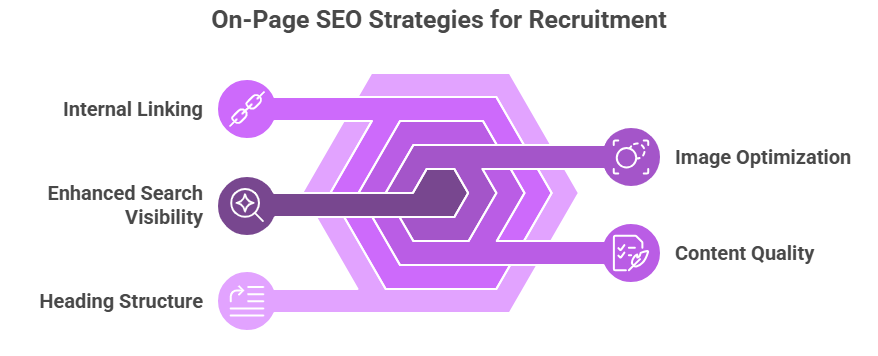
Crafting Optimized Titles and Meta Descriptions
Aligning Metadata with User Intent
Your page titles and meta descriptions are often the first things users see on search engine results pages (SERPs), making them critical for both click-through rates and SEO performance. To optimize them effectively:
- Understand User Intent: Determine whether the searcher’s goal is informational (learning about careers), navigational (finding a specific job board), or transactional (applying for a job). For example:
- Transactional intent: “Apply for Remote Graphic Design Jobs – Hiring Now”
- Informational intent: “Top Skills to Land a Marketing Job in 2025”
- Be Clear and Compelling: Job seekers scan quickly, so keep titles concise (50-60 characters) and meta descriptions around 150-160 characters. Use action-oriented language like “Discover,” “Apply,” “Explore,” or “Find” to encourage clicks.
- Avoid Generic Phrases: Instead of vague titles like “Job Listings,” specify the job role and location, e.g., “Software Developer Jobs in New York | Remote Options Available.”
Using Primary and Secondary Keywords Effectively
Incorporating keywords strategically into your metadata is key:
- Primary Keywords: These are the main terms you want to rank for, such as “digital marketing jobs” or “IT recruitment agency.” Place them at the beginning of your title tag for maximum impact.
- Secondary Keywords: Related terms that support the primary keyword, such as “remote marketing roles” or “tech hiring services.” Include these naturally in meta descriptions to broaden your reach without keyword stuffing.
For example:
- Title: “Digital Marketing Jobs in London – Remote & Full-Time Roles Available”
- Meta Description: “Explore the latest digital marketing jobs in London. Apply now for remote and full-time positions with top employers.”
This approach ensures your metadata is both search-engine friendly and engaging for users.
Structuring Heading Tags (H1, H2, H3…)
Clear, Logical Hierarchies for Different Job Types or Topics
Properly structured heading tags not only improve SEO but also enhance user experience by making your content easier to read and navigate. Here’s how to structure them effectively:
- H1 Tags: Each page should have a single H1 tag, typically the page’s main title. For job listings, this could be the job role, such as “Senior Software Engineer – Remote Opportunity.”
- H2 Tags: Use H2s to outline major sections of the page, like “Job Responsibilities,” “Qualifications,” or “Company Overview.”
- H3 and Beyond: For subsections under H2 headings, use H3s to break down details further. For example, under “Qualifications,” you might have H3 tags for “Technical Skills” and “Soft Skills.”
This hierarchical structure helps search engines understand your content’s organization, improving crawlability and rankings.
Incorporating Relevant Keywords Without Overstuffing
While it’s important to include keywords in your headings, overusing them can lead to keyword stuffing, which negatively affects SEO. To avoid this:
- Be Natural: Write headings that make sense to users first, then optimize with keywords where appropriate. For example, instead of “Best Marketing Jobs | Marketing Jobs for Freshers | Apply Marketing Jobs,” use “Top Marketing Jobs for Fresh Graduates – Apply Today.”
- Use Variations: Incorporate keyword variations and synonyms to maintain a natural flow. For example, if your primary keyword is “IT jobs,” you might also use “tech roles,” “software developer positions,” or “technology careers.”
- Focus on Readability: Prioritize clarity and readability. Well-structured headings not only improve SEO but also enhance the user experience, keeping job seekers engaged longer.
Internal Linking Best Practices
Linking to Practice Area Pages, Location Pages, and Blog Content
Internal linking is a powerful yet often overlooked SEO strategy. It helps distribute link equity throughout your site and guides both search engines and users to important pages.
- Practice Area Pages: If your recruitment agency specializes in industries like healthcare, IT, or finance, link job listings and related blog posts back to these core pages. This strengthens their SEO authority and helps candidates easily explore opportunities within specific fields.
- Location Pages: For multi-regional recruitment agencies, link to location-specific pages such as “Marketing Jobs in New York” or “IT Careers in London.” This not only improves local SEO but also streamlines the candidate’s search experience.
- Blog Content: Use internal links within blog posts to guide readers to related content. For example, an article on “Top Interview Tips for Developers” could link to your latest developer job openings or an IT career guide.
Improving Site Navigation and Candidate Journey
Effective internal linking enhances the candidate journey by making it easier to navigate:
- Breadcrumb Navigation: Helps users understand their current page’s hierarchy and allows quick access to previous sections, improving both usability and SEO.
- Contextual Links: Incorporate links naturally within job descriptions and blog content. Instead of generic text like “click here,” use descriptive anchor text such as “explore remote marketing jobs” to provide clarity and SEO value.
A well-structured internal linking strategy reduces bounce rates, increases session duration, and helps guide candidates toward conversion actions like applying for jobs.
Content Quality and Readability
Writing Compelling Job Descriptions
High-quality job descriptions not only attract more candidates but also improve SEO performance. Here’s how to craft content that resonates:
- Be Clear and Concise: Use straightforward language to describe job responsibilities, qualifications, and benefits. Avoid jargon unless it’s industry-specific and widely understood by the target audience.
- Use Bullet Points: Break down key information like job duties, skills required, and perks into bullet points for easy scanning.
- Incorporate Keywords Naturally: Include relevant keywords (e.g., “remote software developer,” “entry-level marketing assistant”) in the job title, opening paragraph, and throughout the descriptionbut avoid keyword stuffing.
Adding Clear Calls to Action (CTAs) to “Apply Now”
Every job listing should guide candidates toward the next step. Effective CTAs can significantly improve conversion rates:
- Be Direct: Use action-oriented language like “Apply Now,” “Submit Your Resume,” or “Start Your Application Today.”
- Make CTAs Stand Out: Use contrasting buttons or bold links to draw attention without overwhelming the design.
- Test and Optimize: A/B test different CTAs to see which ones drive the most applications. For example, “Apply Now” might outperform “Join Our Team” depending on the audience.
Image Optimization
Using Alt Text for Accessibility and SEO
Alt text serves two critical purposes: improving website accessibility for visually impaired users and providing additional SEO signals to search engines.
- Be Descriptive: Describe the image clearly and concisely. For example, instead of writing “image1,” use “team collaborating in a modern office environment.”
- Include Keywords (When Relevant): If the image supports job-related content, include relevant keywords naturally. For example, “recruitment agency team specializing in healthcare staffing.”
- Avoid Keyword Stuffing: Focus on relevance. Overloading alt text with keywords can harm accessibility and SEO.
Compressing Images for Faster Load Times
Page speed is a key ranking factor, especially for mobile users. Large image files can slow down your site, increasing bounce rates.
- Use Compression Tools to reduce file size without compromising quality.
- Choose the Right Format: Use JPEG for photographs and PNG for graphics with transparent backgrounds. For high-resolution needs, consider next-gen formats like WebP.
- Enable Lazy Loading: This ensures images load only when they’re in the user’s viewport, improving load times.
Optimizing images enhances both user experience and SEO performance.
Technical SEO for Recruitment Websites
Technical SEO is the backbone of any successful recruitment website. While on-page SEO focuses on content and keywords, technical SEO ensures that search engines can effectively crawl, index, and rank your site. This is particularly critical for recruitment websites, where the constant addition of job listings and dynamic content can create technical challenges. Here’s how to address key areas to boost your site’s performance.
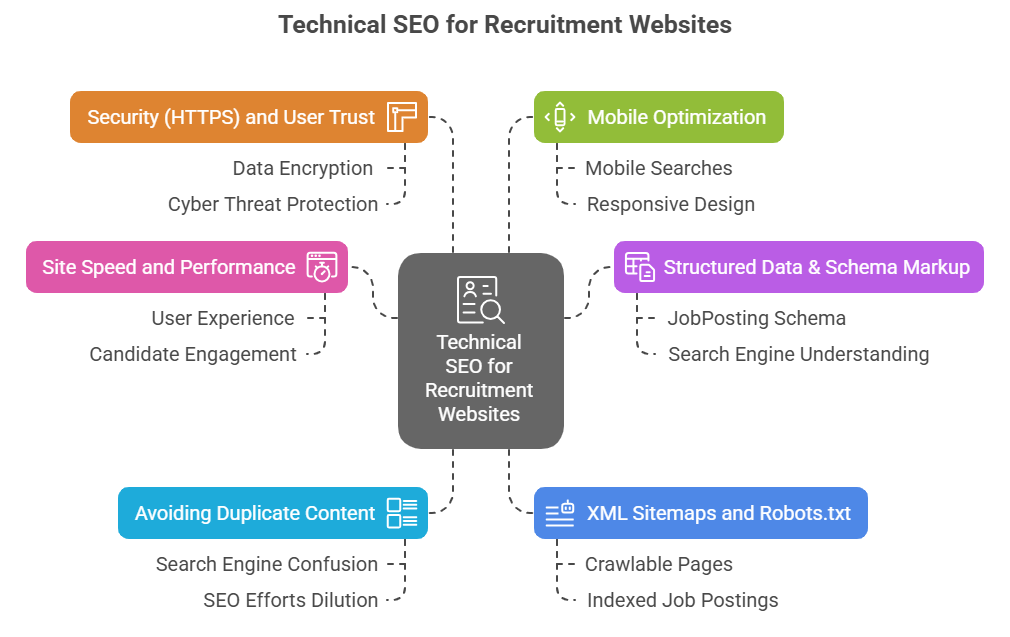
Site Speed and Performance
Why Speed Matters for Candidate Drop-Off Rates
Site speed isn’t just a technical issueit directly impacts user experience and candidate engagement. In the fast-paced world of job hunting, candidates expect quick access to job listings. A delay of even a few seconds can lead to frustration, causing them to abandon your site for a competitor’s.
- Bounce Rates: Studies show that a one-second delay in page load time can increase bounce rates by up to 32%. For recruitment sites, this means potential applicants may leave before even viewing a job description.
- Conversion Rates: Faster websites lead to higher conversion rates. The quicker a candidate can load a job listing, the more likely they are to complete an application.
- SEO Impact: Google uses page speed as a ranking factor, especially with its Core Web Vitals update. Slow-loading pages may rank lower in search results, reducing organic traffic.
Techniques to Optimize Page Load Times
To improve site speed:
- Optimize Images: Compress images and use modern formats like WebP for faster loading.
- Minimize HTTP Requests: Reduce the number of elements (scripts, images, CSS files) that need to load on a page. Combine files where possible.
- Leverage Browser Caching: Store some data on users’ browsers so returning visitors experience faster load times.
- Enable Content Delivery Network (CDN): A CDN distributes your content across multiple servers worldwide, reducing load times for users based on their location.
- Optimize Code: Minify CSS, JavaScript, and HTML to remove unnecessary characters and spaces that slow down load times.
Structured Data & Schema Markup
Adding JobPosting Schema for Rich Snippet Visibility
Structured data, or schema markup, helps search engines understand the content on your pages. For recruitment websites, adding the JobPosting schema can significantly enhance visibility in search results by enabling rich snippets.
- Benefits of JobPosting Schema: It allows job listings to appear with enhanced details such as job title, company name, location, salary, and application deadline directly in search results. This can improve click-through rates by making your listings stand out.
- Implementation: Use JSON-LD (JavaScript Object Notation for Linked Data) to add JobPosting schema to your job listing pages. Key properties include:
- @type: JobPosting
- title: Job title
- description: Job description
- hiringOrganization: Company details
- jobLocation: Location information
- datePosted and validThrough: Posting dates
Google’s Rich Results Test tool can verify if your schema is correctly implemented.
Marking Up Reviews, Ratings, and Company Details
In addition to job postings, you can use structured data to enhance other elements of your site:
- Reviews and Ratings: If your site features company reviews or candidate testimonials, mark them up using the Review schema. This can display star ratings in search results, boosting credibility.
- Organization Schema: Add structured data for your company, including details like logo, contact information, and social media profiles. This helps improve your site’s knowledge panel in Google search.
Structured data not only enhances visibility but also improves click-through rates, driving more traffic to your job listings.
Avoiding Duplicate Content
Managing Multiple Job Listings and Reposts
Recruitment websites often face duplicate content issues due to similar job listings posted across different locations, categories, or even multiple times for the same role. This can confuse search engines, diluting your SEO efforts and harming rankings.
- Unique Content: Wherever possible, create unique job descriptions, even for similar roles. Customize details like responsibilities, qualifications, and location-specific information.
- Dynamic URL Management: If your website generates multiple URLs for the same job (e.g., with different tracking parameters), ensure these don’t create duplicate content issues.
Canonical Tags and Noindex Directives When Necessary
To manage unavoidable duplicates:
- Canonical Tags: Use canonical tags (<link rel=”canonical” href=”URL”>) to tell search engines which version of a page is the preferred one. This consolidates SEO value and avoids duplicate content penalties.
- Noindex Directives: For pages that don’t need to be indexed (e.g., expired job listings, duplicate filters), apply a noindex directive. This prevents search engines from indexing them while keeping the pages accessible to users.
- Parameter Handling in Google Search Console: Use Google Search Console to specify how URL parameters should be treated, reducing the risk of duplicate content caused by dynamic URLs.
By proactively addressing duplicate content, you ensure search engines focus on your most valuable pages, improving rankings and user experience.
XML Sitemaps and Robots.txt
Ensuring Search Engines Can Crawl and Index Crucial Pages
An XML sitemap is like a roadmap for search engines, guiding them to the most important pages on your website. For recruitment sites that regularly update job postings, having an up-to-date sitemap ensures that new listings are discovered and indexed quickly.
- Key Elements to Include:
- Job Listing Pages: Highlight new, active, and high-priority job postings.
- Category/Location Pages: Ensure pages like “Marketing Jobs in London” or “IT Roles in New York” are indexed.
- Blog and Resource Pages: Include content that supports your SEO strategy, such as career advice articles or hiring tips.
A robots.txt file, on the other hand, tells search engines which pages or sections they should or shouldn’t crawl.
- Allow Search Engines to Crawl Important Pages: Make sure key job listings, category pages, and blog content are accessible.
- Block Non-Essential Pages: Prevent indexing of duplicate content, admin panels, or internal search results using Disallow directives.
Submitting Sitemaps to Google Search Console
While search engines can often find your sitemap automatically, manually submitting it through Google Search Console improves efficiency:
- Log into Google Search Console.
- Go to ‘Sitemaps’ under the ‘Index’ section.
- Enter the URL of your XML sitemap (e.g., https://www.yoursite.com/sitemap.xml).
- Click ‘Submit’.
This process helps Google index your pages faster, particularly useful when new job listings are posted or significant site updates occur.
Security (HTTPS) and User Trust
Importance of Secure Sites for Application Forms
Security is non-negotiable for recruitment websites, especially when handling sensitive information like resumes, personal details, and job applications. HTTPS (Hypertext Transfer Protocol Secure) encrypts the data exchanged between your website and the user’s browser, protecting against data breaches and cyber threats.
- Why It Matters for SEO:
- Google Ranking Signal: Google uses HTTPS as a ranking factor, meaning secure sites are favored in search results.
- User Trust: Candidates are more likely to submit applications on secure sites. A “Not Secure” warning in the browser can deter users, negatively impacting conversion rates.
To secure your site:
- Obtain an SSL certificate from a trusted provider.
- Migrate your entire website to HTTPS, ensuring proper 301 redirects from HTTP to HTTPS to preserve SEO value.
- Update internal links and canonical tags to reflect HTTPS URLs.
Data Privacy and Compliance Considerations
Beyond encryption, recruitment websites must adhere to data privacy regulations, especially when operating internationally:
- GDPR (General Data Protection Regulation): If you collect data from EU citizens, ensure compliance with GDPR by:
- Obtaining clear consent for data collection.
- Providing transparent privacy policies.
- Allowing users to request data deletion.
- CCPA (California Consumer Privacy Act): For businesses targeting California residents, provide options for users to opt out of data sharing and disclose what data is collected.
Best Practices for Data Privacy:
- Use secure servers for storing candidate information.
- Regularly update software to patch security vulnerabilities.
- Implement two-factor authentication for administrative access.
A secure, compliant website not only protects your candidates’ data but also enhances your brand’s credibility, leading to higher engagement and application rates.
Mobile Optimization
Ensuring Pages Are Mobile-Friendly
With the majority of job searches happening on mobile devices, mobile optimization is non-negotiable. Key best practices include:
- Responsive Design: Ensure your website adapts seamlessly to different screen sizes. Test layouts on various devices to confirm that job listings, CTAs, and forms are user-friendly.
- Simplify Navigation: Use mobile-friendly menus and large, clickable buttons. Ensure job filters are easy to use on smaller screens.
- Optimize Load Speed: Compress images, minimize code, and leverage browser caching to improve load times on mobile networks.
The Impact on Google’s Mobile-First Indexing
Google’s mobile-first indexing means the mobile version of your website is the primary source for ranking and indexing. This shift highlights the importance of mobile optimization:
- Content Parity: Ensure the mobile version contains the same valuable content as the desktop version, including text, images, and internal links.
- Fast Load Times: Mobile page speed is a ranking factor. Use Google’s PageSpeed Insights to identify performance issues.
- Structured Data: Implement structured data on both desktop and mobile versions to enhance search visibility through rich snippets.
Failing to optimize for mobile can negatively impact rankings, traffic, and, ultimately, candidate conversions.
Off-Page SEO for Recruitment Agencies
Off-page SEO is critical for recruitment agencies looking to improve their online visibility, establish credibility, and attract both candidates and clients. While on-page SEO focuses on optimizing content within your website, off-page SEO revolves around activities outside of your site that influence search engine rankings. The cornerstone of off-page SEO is link building, which helps search engines determine the authority and relevance of your website.
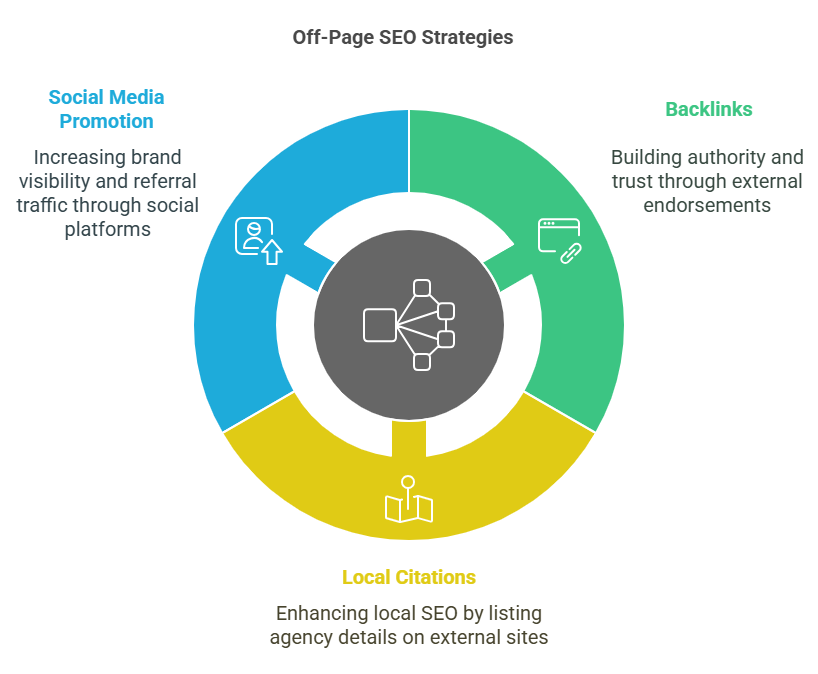
The Value of Backlinks for Recruiters
Building Authority and Trust
Backlinkslinks from other websites pointing to yoursare like endorsements in the eyes of search engines. For recruitment agencies, they serve two key purposes:
- SEO Authority: High-quality backlinks from reputable sites signal to search engines that your website is credible and authoritative. This can significantly boost your rankings on search engine results pages (SERPs).
- Trustworthiness: Links from respected industry websites, educational institutions, or well-known job boards help build trust with potential candidates and clients. When users see your agency mentioned on reputable platforms, it reinforces your legitimacy.
It’s important to focus on earning quality backlinks rather than chasing sheer quantity. A few links from authoritative sources can have a greater impact than dozens from low-quality sites.
Referral Traffic from Reputable Job Boards or Industry Sites
Backlinks aren’t just for SEOthey’re also powerful sources of referral traffic. Getting featured on prominent job boards, industry blogs, or business websites can drive targeted traffic directly to your recruitment agency. This is especially valuable when the linking site’s audience aligns with your target candidates or clients.
- Example: A backlink from a top industry site like SHRM (Society for Human Resource Management) or a niche job board like Stack Overflow (for tech roles) can result in high-quality leads for your agency.
Link Acquisition Strategies
Earning high-quality backlinks requires strategic outreach and relationship-building. Here are some proven tactics tailored for recruitment agencies:
Guest Posting
Guest posting involves writing articles for other websites within your industry, allowing you to showcase expertise while earning backlinks.
- Target Industry Blogs: Identify authoritative blogs, HR websites, and career advice platforms that accept guest contributions. Offer content like “Top Hiring Trends in 2025” or “How to Attract Gen Z Talent.”
- Include Natural Links: When writing guest posts, include relevant links back to your agency’s websitewhether it’s a link to a specific service page, a case study, or a blog post you’ve published.
- Benefit Beyond SEO: Guest posts also position your agency as an industry thought leader, which can attract both clients and candidates organically.
Public Relations (PR)
Effective PR campaigns can secure valuable backlinks from media outlets, online publications, and authoritative blogs.
- Press Releases: Announce new services, partnerships, or significant achievements through press releases distributed to relevant media outlets.
- Expert Commentary: Offer your insights to journalists covering employment trends, recruitment strategies, or labor market updates. Platforms like HARO (Help A Reporter Out) connect experts with reporters seeking industry insights.
- Media Features: Aim for features in reputable industry publications or business websites, which often include backlinks to your agency.
“Copycat” Methods
The copycat link-building strategy involves identifying where competitors are earning backlinks and replicating their success.
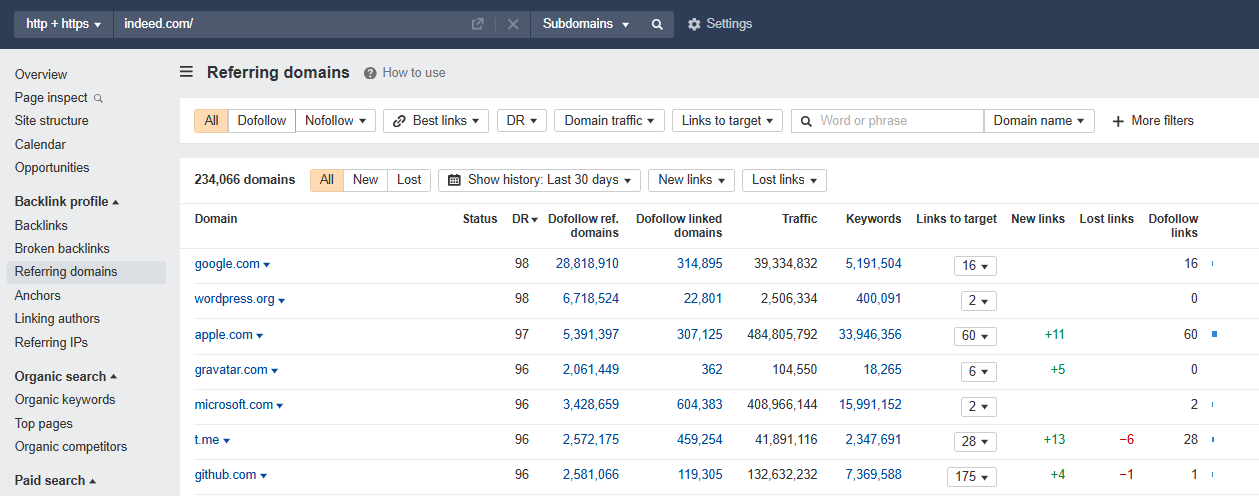
- Analyze Competitor Backlinks: Use SEO tools like Ahrefs, SEMrush, or Moz to uncover competitor backlink profiles. Look for opportunities where your agency could also be featured, such as industry directories, blogs, or news articles.
- Reach Out: If a competitor was mentioned in an industry roundup or listicle (e.g., “Top Recruitment Agencies in Tech”), contact the publisher to suggest adding your agency as well.
- Content Gap Filling: If a competitor’s content attracted backlinks but lacks depth, create a more comprehensive version and reach out to those linking sites, offering your improved resource.
Building Relationships with Industry Influencers and Career-Related Blogs
Networking with industry influencers, HR leaders, and career bloggers can organically lead to backlink opportunities.
- Engage on Social Media: Follow and interact with thought leaders in the recruitment space. Share their content, leave thoughtful comments, and establish connections before pitching collaboration ideas.
- Collaborative Content: Co-create content like podcasts, webinars, or expert roundups. Participants often link back to the content from their own platforms.
- Testimonials and Case Studies: Offer testimonials for industry tools, software, or services you use. Companies often publish these on their websites with a link back to your agency.
Social Media Promotion
Sharing Job Postings on LinkedIn, Facebook, Twitter, etc.
Social media platforms are powerful channels for promoting job postings and driving traffic back to your website. While social signals (likes, shares, comments) may not directly influence search engine rankings, they contribute to brand visibility, generate referral traffic, and indirectly support SEO efforts.
- LinkedIn: As the leading professional networking platform, LinkedIn is ideal for sharing job opportunities, industry insights, and thought leadership content. Use targeted posts, company updates, and LinkedIn Groups to engage with relevant audiences. Don’t forget to optimize job posts with relevant keywords and hashtags to increase discoverability.
- Facebook & Twitter: Both platforms are excellent for reaching broader audiences. Facebook’s job posting feature allows you to share openings directly, while Twitter’s real-time nature makes it effective for promoting urgent job roles using trending hashtags (e.g., #NowHiring, #TechJobs).
- Instagram & TikTok: For industries targeting younger demographics (like creative, marketing, or tech roles), visual platforms like Instagram and TikTok can be powerful. Share employee testimonials, behind-the-scenes content, or quick job application tips to build engagement.
Strengthening Employer Brand Through Social Engagement
An active social media presence strengthens your employer brand, making your agency more appealing to both candidates and clients:
- Engage with Followers: Respond promptly to comments and messages. Engaging in conversations helps build trust and humanizes your brand.
- Showcase Company Culture: Share success stories, team highlights, recruitment events, and client testimonials. This fosters a sense of community and positions your agency as a leader in the recruitment space.
- Use Paid Social Advertising: Boost high-priority job postings with paid ads on LinkedIn or Facebook to reach targeted demographics and geographies.
Social media not only drives traffic but also encourages brand mentions, which can indirectly benefit your SEO.
Local Citations and Industry Directories
Listing Your Agency on Local Business and Niche Directories
Local citations are mentions of your recruitment agency’s name, address, and phone number (NAP) on external websites. They play a significant role in local SEO, helping search engines verify your agency’s legitimacy and relevance to specific locations.
- Google Business Profile: Claim and optimize your Google Business Profile to improve local search visibility. Ensure your NAP details are consistent across all platforms.
- Local Directories: List your agency on reputable business directories like Yelp, Yellow Pages, and local Chamber of Commerce sites. Consistent citations improve local rankings, especially for candidates searching for agencies nearby (e.g., “recruitment agencies in Chicago”).
Leveraging Recruitment-Specific Sites for Backlinks
Recruitment-focused directories and job boards are valuable not just for exposure but also for earning high-quality backlinks:
- Industry Directories: List your agency on niche directories like Clutch.co, UpCity, or Recruiter.com. These platforms often have high domain authority, providing strong SEO benefits.
- Job Boards with Backlink Opportunities: Partner with job boards like Indeed, Glassdoor, or AngelList, which may offer backlink opportunities through company profiles or job listings.
- Association Memberships: If you’re part of professional organizations like the American Staffing Association (ASA) or National Association of Professional Women (NAPW), ensure your profile includes a backlink to your website.
When listing your agency, ensure that all details (name, address, website URL) are accurate and consistent across directories. This improves local search performance and strengthens your site’s authority.
Creating and Optimizing Practice Area Pages
A practice area page is a dedicated webpage that focuses on a specific niche or specialty segment within your recruitment services. These pages are designed to attract candidates and clients searching for specialized roles or recruitment solutions in particular industries.
- Defining the Niche: A practice area could be based on industries (e.g., technology, healthcare, finance), job functions (e.g., sales, marketing, engineering), or specific roles (e.g., software developers, data analysts, project managers). The goal is to create a focused page that showcases your expertise in that specific area.
- Why Specialized Pages Rank Better for Long-Tail Queries: Long-tail keywords are longer, more specific search phrases like “IT recruitment agency for fintech startups” or “healthcare executive search firm in Chicago.” Practice area pages are highly effective for capturing these queries because they address specific search intent with relevant, targeted content. This leads to:
- Higher conversion rates because the content matches exactly what the searcher is looking for.
- Lower competition compared to broad keywords like “recruitment agency.”
- Improved user experience as visitors find content tailored to their needs.
By creating optimized practice area pages, recruiters can dominate niche markets both in search rankings and client acquisition.
Building a Strong Practice Area Page
A well-structured practice area page doesn’t just rank wellit converts visitors into candidates or clients. Here’s how to build one effectively:
- Clear Introduction
Start with a compelling introduction that clearly defines the niche and communicates your expertise. For example:- “At [Agency Name], we specialize in connecting top-tier software developers with leading tech companies across the U.S. Our deep industry knowledge and extensive network ensure we find the perfect fit for both candidates and employers.”
- This immediately signals relevance to both search engines and visitors.
- Service Details
Outline the recruitment services you offer within that niche. Be specific:- Roles You Cover: Mention job titles (e.g., front-end developers, DevOps engineers, AI specialists).
- Industries Served: Highlight industries if applicable (e.g., fintech, healthtech, e-commerce).
- Recruitment Solutions: Describe services like executive search, contract staffing, or permanent placement.
- Use structured headings (H2s and H3s) to break up content and improve readability, which also helps with SEO.
- Relevant Keywords
Integrate primary and secondary keywords naturally throughout the page. This includes:- Primary Keywords: E.g., “IT recruitment agency,” “healthcare staffing solutions.”
- Secondary Keywords: E.g., “remote software developer jobs,” “clinical research recruitment firm.”
- Place keywords in critical areas such as:
- Page title and meta description
- Headings (H1, H2)
- First 100 words of content
- Image alt text (if applicable)
- Incorporating Success Stories or Case Studies
Adding success stories or case studies boosts credibility and enhances SEO through unique content. For example:- Case Study Example: “How We Helped a Fintech Startup Hire 15 Developers in 3 Months”this not only showcases results but also includes niche-specific keywords.
- Client Testimonials: Real feedback from satisfied clients in the niche can improve trust and add fresh, user-generated content that search engines value.
- Clear Calls to Action (CTAs)
Guide visitors toward the next step with strong CTAs like:- “Find Your Next [Niche] Role”
- “Partner with [Agency Name] for Expert [Industry] Recruitment”
- “Schedule a Consultation Today”
- Position CTAs prominently on the page to encourage conversions.
- Internal Linking
Link to related job listings, industry blog posts, or other practice area pages to improve site navigation and SEO. For example:- “Looking for roles beyond software development? Check out our [Data Science Jobs] page.”
Listing Typical Roles and Case Studies
Boosting Keyword Variety with Detailed Role Breakdowns
One of the simplest ways to improve your SEO is by listing the typical roles you recruit for. This helps in two key ways:
- Keyword Diversity: When you include a wide range of job titles, skills, and industries, you naturally expand your keyword footprint. Instead of just targeting broad terms like “IT recruitment,” you can rank for more specific long-tail keywords such as:
- “Front-end developer recruitment”
- “Executive assistant staffing services”
- “Data analyst hiring solutions”
- Improved Search Visibility: Detailed role breakdowns help you capture candidates and clients searching for highly specific positions. For example, listing roles like “DevOps Engineer,” “Cybersecurity Analyst,” or “Digital Marketing Specialist” increases the likelihood of your site appearing in relevant search queries.
Best Practices:
- Create dedicated sections or pages for each role category, using H2 or H3 headings for clear structure.
- Include variations of job titles (e.g., “Project Manager,” “Program Manager,” “Agile Project Lead”) to capture different search intents.
- Describe each role briefly, incorporating relevant skills, responsibilities, and industries served.
Demonstrating Track Record with Relevant Examples
Adding case studies is a powerful way to demonstrate your recruitment success while enhancing SEO. They provide real-world proof of your expertise and give you opportunities to include niche-specific keywords naturally.
How to Structure an SEO-Friendly Case Study:
- Introduction: Briefly describe the client’s industry and recruitment challenge (e.g., “A fintech startup in New York struggling to hire Python developers.”).
- The Challenge: Highlight the specific hiring problem (e.g., “Difficulty sourcing candidates with experience in Django and cloud infrastructure.”).
- The Solution: Explain how your agency approached the problem, mentioning relevant keywords like “IT talent sourcing” or “remote developer recruitment.”
- The Results: Showcase quantifiable outcomes (e.g., “Successfully placed 5 developers within 30 days, reducing time-to-hire by 40%.”).
By weaving in targeted keywords naturally, case studies not only build credibility but also improve search engine rankings.
Peppering Testimonials With Keywords
Subtle Ways to Embed Target Phrases
Client and candidate testimonials are valuable for SEO because they offer authentic, user-generated content. While it’s essential to keep testimonials genuine, you can subtly encourage the inclusion of target keywords.
Tactics for Embedding Keywords Naturally:
- Prompt Specific Feedback: Instead of generic requests like “Share your experience,” ask specific questions:
- “How did our tech recruitment services help you find the right candidate?”
- “Can you describe your experience with our healthcare staffing solutions?”
- This encourages clients to naturally mention keywords like “tech recruitment” or “healthcare staffing.”
- Edit for Clarity (With Permission): If a testimonial lacks clarity, you can lightly edit it (with client approval) to include relevant phrases without altering the message. For example:
- Before: “They helped us find great candidates quickly.”
- After: “The team helped us find top-tier digital marketing candidates quickly.”
- Highlight Keywords Strategically: When displaying testimonials on your site, consider bolding or emphasizing key phrases to draw attention for both users and search engines.
Increasing Trust Through Real Client or Candidate Feedback
Authentic testimonials build trust, which indirectly supports SEO by improving engagement metrics like time on site and conversion rates.
Best Practices:
- Diverse Testimonials: Include feedback from both clients and candidates to appeal to different audiences.
- Visual Elements: Add photos, names, or company logos (with permission) to enhance credibility.
- Placement: Feature testimonials prominently on relevant pages, such as:
- Practice Area Pages: Testimonials related to specific industries or roles.
- Case Study Pages: Reinforce success stories with client quotes.
- Homepage: Highlight standout testimonials for immediate impact.
Crafting Effective Location Pages
In recruitment SEO, the definition of “location” isn’t limited to physical office addresses. It can refer to:
- Single-Office Structures: If your recruitment agency operates from one location, focus on optimizing for that city or region. Create a dedicated page like “IT Recruitment Services in Chicago” with localized content highlighting your expertise in that market.
- Multiple-Office Structures: Agencies with offices in different cities should create separate, unique pages for each location. For example:
- “Tech Recruitment Agency in New York”
- “Healthcare Staffing Solutions in Los Angeles” Ensure each page has distinct content to avoid duplication issues.
- Remote or Hybrid Roles: The rise of remote and hybrid work adds complexity. Instead of traditional location pages, you might target broader terms like “Remote Marketing Jobs” or “Virtual IT Recruitment Services”. Clarify whether roles are fully remote, hybrid, or location-restricted (e.g., “Remote roles available for candidates based in the U.S.”).
Understanding these distinctions helps tailor your SEO strategy effectively for different recruitment models.
Writing Keyword-Rich, Relevant Content
To rank well in local search results, your content must be both relevant and keyword-optimized.
Key Strategies:
- Include City, State, or Region-Based Terms: Integrate localized keywords naturally throughout the content. For example:
- “We specialize in placing top tech talent in Austin’s thriving startup ecosystem.”
- “Our finance recruitment agency serves clients across New Jersey and New York.”
- Highlight Local Business Landmarks or Unique Hiring Specifics: Adding local context improves relevance:
- “Located near Seattle’s tech hub in South Lake Union, we’ve helped companies like XYZ scale their engineering teams.”
- Mentioning local industries or employment trends (e.g., “Charlotte’s booming fintech sector”) shows familiarity with the area.
- Avoid Keyword Stuffing: Focus on natural language. Instead of repeating “recruitment agency in Chicago” excessively, vary phrases with synonyms like “staffing services in Chicago” or “talent acquisition experts in the Windy City.”
This approach enhances both SEO performance and user engagement.
Title Optimization for Each Location
The title tag is one of the most important on-page SEO elements. It should clearly convey the page’s purpose while incorporating geographic keywords.
Best Practices:
- Tailor Headings for Geographic Relevance: Craft unique titles for each location page, such as:
- “IT Recruitment Agency in San Francisco | [Agency Name]”
- “Healthcare Staffing Solutions – Serving Boston, MA”
- Incorporate Primary Keywords: Place the most important keywords at the beginning of the title for maximum impact.
- Avoid Thin or Duplicated Content: Don’t just copy and paste content from one location page to another, swapping out city names. Instead:
- Highlight city-specific industries, employment trends, or case studies.
- Include localized testimonials from clients or candidates in that region.
Unique, keyword-rich titles and content improve click-through rates and reduce the risk of duplicate content penalties from search engines.
Linking Practice Area Pages and Location Pages
A strong internal linking strategy improves site architecture, making it easier for both search engines and users to navigate your website.
How to Link Effectively:
- From Location Pages to Practice Area Pages: If your “Recruitment Services in Chicago” page mentions IT roles, link to your dedicated “IT Recruitment” practice area page. This helps distribute SEO authority and keeps users engaged.
- From Practice Area Pages to Location Pages: On your “Marketing Recruitment Services” page, include links to regional pages like:
- “Looking for marketing talent in New York? Check out our NYC recruitment services.”
- Cross-Linking Between Location Pages: If relevant, link between nearby city pages (e.g., Chicago to Milwaukee) to enhance local SEO signals.
This interconnected structure boosts SEO, improves user navigation, and helps search engines understand the relationship between pages.
Handling Virtual or Remote Hiring
With the shift toward remote work, recruitment websites must adapt location strategies accordingly.
Adapting Pages for Remote or Global Candidates:
- Create Dedicated Remote Pages: Instead of generic listings, have pages like:
- “Remote Software Developer Jobs”
- “Virtual Recruitment Services for Global Companies”
- Clarify Location-Based Restrictions: Even for remote roles, some jobs may have geographic requirements (e.g., due to tax laws or time zones). Clearly specify:
- “Remote role available for candidates based in the U.S. Eastern Time Zone.”
- “Open to remote applicants within the EU.”
- Target Global Keywords: If your agency operates internationally, optimize pages for broader terms like:
- “Global Recruitment Agency for Tech Talent”
- “Remote Hiring Solutions for Startups Worldwide”
Adapting to remote hiring trends ensures your site remains competitive in the evolving recruitment landscape.
Optimizing Job Postings for SEO in Recruitment
Creating job postings optimized for search engines can significantly improve visibility and attract qualified candidates. However, SEO requires a delicate balance between search optimization and crafting an engaging, candidate-friendly experience. Below, we’ll explore key strategies to optimize job listings effectively.
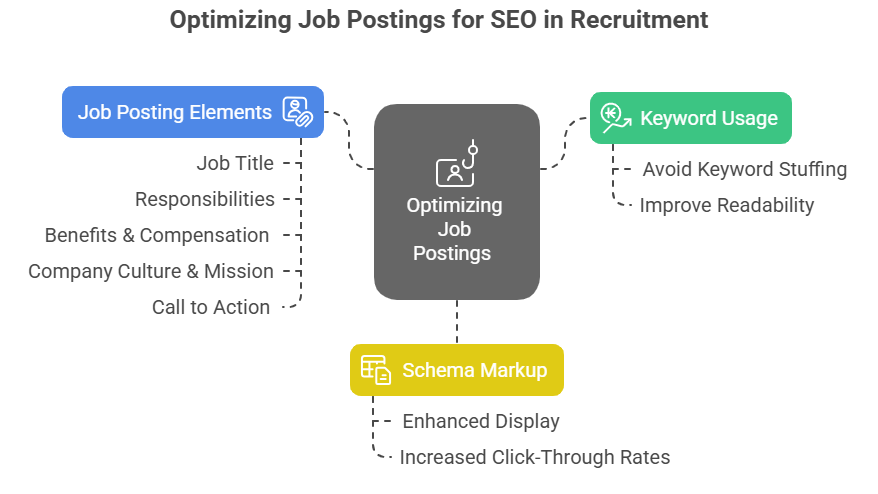
Why Additional Keywords Aren’t Always Necessary
Many recruiters assume that stuffing job postings with multiple keywords will improve their rankings. However, this approach can backfire, making job descriptions redundant and difficult to read. Here’s why:
Balancing Descriptive Job Titles with SEO
Search engines favor clarity over keyword stuffing. While it might be tempting to include variations like “Marketing Manager | Digital Marketing Specialist | Online Marketing Manager,” this dilutes the impact of the job title. Instead:
- Use a widely recognized job title. Search for the most common industry term candidates use (e.g., “Content Strategist” rather than “Digital Storytelling Expert”).
- Avoid unnecessary adjectives and buzzwords. Phrases like “Rockstar Developer” or “Sales Ninja” might be catchy, but they’re not search-friendly.
- Consider including one keyword variation, if relevant. A format like “Marketing Manager – SEO & Digital Strategy” ensures clarity without being excessive.
Avoiding Repetitive or Spammy Listings
Duplicate job postings with slight variations can hurt rankings. Google for Jobs and LinkedIn’s algorithm may filter out overly repetitive listings, considering them spammy. To maintain high visibility:
- Ensure each listing is unique, even if hiring for similar roles. Adjust content to reflect location, department, or specific team needs.
- Focus on candidate experience rather than just ranking. Write job descriptions that feel human, not robotic or keyword-driven.
- Use long-tail keywords naturally within the job summary instead of repeating exact-match terms.
Essential Elements of a Job Posting
A well-structured job listing not only improves SEO but also engages the right candidates. Here’s what every optimized job posting should include:
1. Job Title
- Keep it concise and industry-standard.
- Avoid internal jargon or creative naming conventions.
2. Responsibilities
- Use bullet points for easy readability.
- Highlight key duties and avoid overly generic descriptions.
3. Benefits & Compensation
- Transparency about salary and perks improves engagement.
- Use structured data (discussed below) to enhance visibility.
4. Company Culture & Mission
- Candidates increasingly seek alignment with company values.
- Showcase your unique work environment and team culture.
5. Call to Action (CTA)
- Encourage action with clear next steps: “Apply Now,” “Submit Your Resume,” or “Schedule an Intro Call.”
- Use engaging, actionable language.
Engaging Copy That Appeals to Target Candidates
Beyond SEO, a job listing must resonate with job seekers. To craft compelling copy:
- Speak directly to the candidate, using “you” and “your” instead of just “the ideal candidate.”
- Highlight career growth opportunities within your company.
- Keep sentences concise and use active language to maintain engagement.
Schema Markup for Job Listings
One of the most effective yet underutilized SEO techniques in recruitment is schema markup. This structured data format helps search engines display enhanced job postings, increasing click-through rates.
Enabling Rich Results on Search Engines
Google for Jobs prioritizes listings that use JobPosting schema markup, allowing for:
- Increased visibility in search results.
- Rich snippets displaying salary, location, job type, and more.
- Higher applicant engagement due to detailed preview information.
Key Fields to Include in Job Schema Markup
To maximize the effectiveness of structured data, include:
| Schema Field | Description |
|---|---|
| Title | Matches the job posting title. |
| Description | The main job summary (keep it clear and engaging). |
| Date Posted | Helps candidates find the most relevant openings. |
| Hiring Organization | Your company’s name and website. |
| Job Location | City, state, and remote/hybrid options. |
| Employment Type | Full-time, part-time, contract, etc. |
| Base Salary | Optional but highly recommended for transparency. |
Blogging for Topical Authority in SEO for Recruiters
For recruiters looking to boost their online visibility, blogging isn’t just a nice-to-have; it’s a critical strategy for building topical authority. When your website consistently publishes valuable, relevant content, search engines start recognizing it as an expert resource in the recruitment space. This not only improves rankings but also establishes trust with potential candidates and clients.
Let’s dive into the key strategies for using blogging to strengthen your SEO efforts.
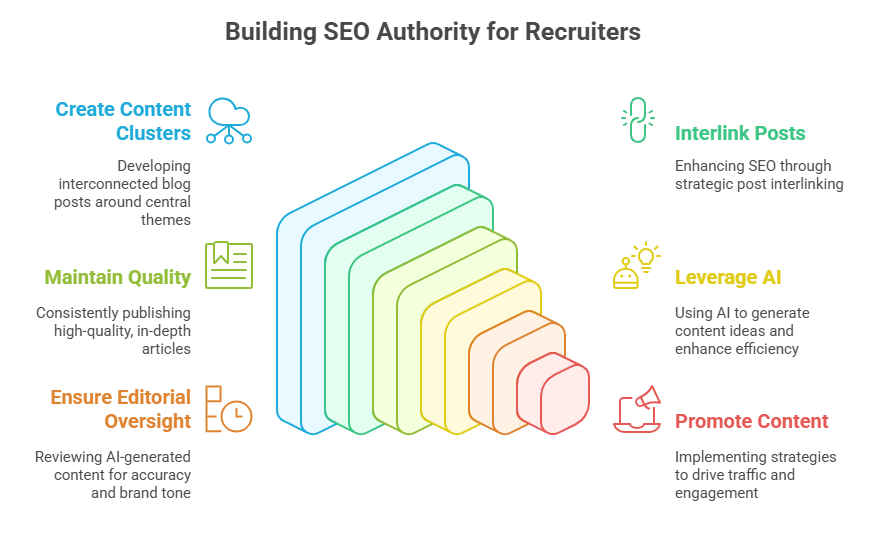
Content Clusters and Topic Relevance
To dominate search rankings, recruiters need more than random blog poststhey need content clusters. This strategy involves creating interconnected blog posts around central themes, signaling to search engines that you’re an authority on specific topics.
Creating Themed Groups of Content
Content clusters start with a pillar post, a comprehensive article covering a broad topic. Supporting this are cluster postsnarrower articles that delve into subtopics and link back to the pillar content. For recruiters, this could look like:
- Pillar Topic: The Ultimate Guide to Successful Job Interviews
- Cluster 1: Top 10 Behavioral Interview Questions and How to Answer Them
- Cluster 2: Interview Body Language Tips That Make a Difference
- Cluster 3: Common Mistakes Candidates Make in Virtual Interviews
Similarly, for client-facing content:
- Pillar Topic: Modern Recruitment Strategies for Businesses
- Cluster 1: How to Improve Your Hiring Process in 2024
- Cluster 2: The Benefits of Working with Recruitment Agencies
- Cluster 3: Diversity Hiring: Why It’s More Than Just a Buzzword
Interlinking Blog Posts to Signal Expertise
Interlinking isn’t just about navigationit’s an SEO powerhouse. When you link related blog posts:
- Search engines understand the relationship between topics, boosting topical authority.
- Users stay longer on your site, reducing bounce rates and increasing engagement metrics.
- You create a logical content hierarchy, helping both Google and your audience find relevant information easily.
Best practices include:
- Linking from cluster posts back to the pillar post (and vice versa).
- Using anchor text that reflects the linked topic naturally.
- Regularly updating old posts to add new internal links as fresh content is published.
Quality Content and Frequent Updates
Consistency is key when it comes to content marketing. Recruiters who regularly publish high-quality, in-depth articles not only improve their SEO but also position themselves as thought leaders in the industry.
Publishing Regular, In-Depth Articles for Candidates and Clients
High-quality content isn’t just about word countit’s about value. Aim to create articles that:
- Answer specific questions candidates or hiring managers are searching for.
- Provide actionable insights based on real recruitment experiences.
- Include data, statistics, or case studies to support claims.
For example:
- “How to Negotiate a Job Offer: A Recruiter’s Insider Tips”
- “Why Your Company’s Hiring Process Might Be Costing You Top Talent”
- “The Future of Remote Work: What Recruiters Need to Know”
Showcasing Thought Leadership in Recruitment Trends
To stand out, don’t just rehash common advice. Showcase unique perspectives by:
- Writing about emerging trends in recruitment technology, AI, or talent acquisition.
- Sharing personal insights or success stories from your own recruiting experience.
- Offering expert commentary on industry news or changes in hiring regulations.
Publishing frequency matters too. Aim for at least 2–4 posts per month to keep your site fresh, but prioritize quality over quantity.
Leveraging AI for Content Ideas
Artificial Intelligence can be very helpful to recruiters looking to streamline their content strategy. While AI can’t replace human insight, it can certainly enhance efficiency and spark creativity.
Using AI Tools for Keyword Suggestions and Competitor Analysis
AI-powered tools like ChatGPT, Jasper, or SEMrush can help with:
- Keyword Research: Discover trending search terms candidates and clients are using.
- Competitor Analysis: Identify content gaps by analyzing top-performing recruitment blogs.
- Content Ideation: Generate outlines or topic suggestions based on SEO data.
For instance, you could input: “Recruitment trends 2024” into an AI tool and receive a list of related blog ideas like:
- “How Gen Z is Changing the Job Market”
- “The Role of AI in Modern Recruiting”
- “Why Remote Work Policies Matter for Talent Retention”
Maintaining Editorial Oversight for Accuracy and Tone
While AI can generate ideas, it’s essential to:
- Review all AI-generated content for accuracy, especially in legal or compliance-related areas.
- Ensure the tone matches your brand’s voiceauthentic, professional, and human.
- Add personal anecdotes, case studies, or opinions that AI can’t replicate.
Think of AI as a content assistant, not a replacement for genuine thought leadership.
Promoting Blog Content
Creating great content is only half the battle. To maximize its impact, recruiters need a solid promotion strategy that drives traffic and engagement.
Sharing on Social Media, Newsletters, and Outreach Campaigns
- Social Media: Share blog posts on LinkedIn, Twitter, and industry-specific groups. Use recruitment hashtags to reach a broader audience.
- Email Newsletters: Curate your top blog posts into a monthly newsletter targeting clients and candidates.
- Outreach Campaigns: Partner with industry influencers, guest post on reputable sites, or collaborate with other recruiters to expand your reach.
Repurpose content into different formats:
- Turn blog posts into infographics, short videos, or carousel posts for social media.
- Create webinars or podcast episodes based on popular articles.
Encouraging Readers to Subscribe or Comment
Engagement signalslike comments, shares, and subscriptionscan boost SEO indirectly. To encourage interaction:
- End posts with a question to spark discussion: “What’s the biggest hiring challenge you’ve faced this year?”
- Add clear CTAs like “Subscribe for weekly recruitment insights” or “Share this post if you found it helpful.”
- Respond to comments promptly to foster a sense of community and keep the conversation going.
Measuring Recruitment SEO Success
Optimizing your recruitment website for search engines is just the first step. To ensure your efforts are driving real results, you need to measure performance effectively. Understanding which SEO strategies are workingand which aren’tcan help you refine your approach, attract more qualified candidates, and reduce hiring costs.
In this section, we’ll cover the key metrics, tools, and strategies for tracking and optimizing SEO efforts.
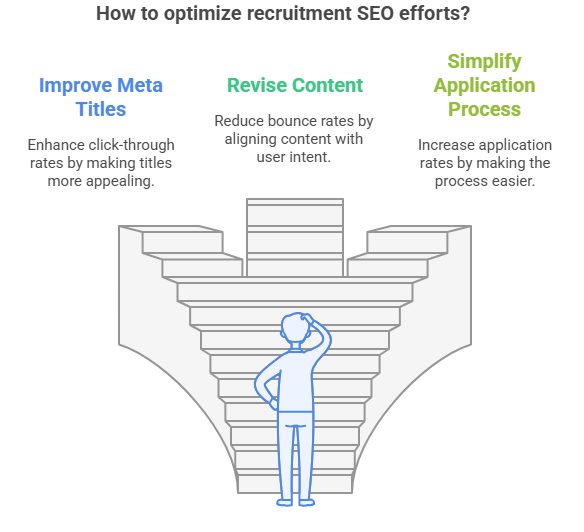
Defining Key Metrics
To gauge the success of your SEO efforts, focus on metrics that reflect both search visibility and candidate engagement. These metrics provide insight into how well your site attracts traffic and converts visitors into applicants.
1. Click-Through Rate (CTR)
CTR measures the percentage of people who click on your job listings or blog posts after seeing them in search results. A high CTR often indicates that your meta titles and descriptions are compelling and relevant.
- Formula: (Clicks ÷ Impressions) × 100
- Why It Matters: A low CTR suggests that even if your page ranks well, it’s not enticing enough to generate clicks.
- How to Improve: Optimize meta titles, add clear value propositions, and use power words like “Top,” “Best,” or “Ultimate Guide.”
2. Conversion Rate
For recruiters, conversions often mean job applications submitted, but they can also include newsletter sign-ups or contact form submissions.
- Formula: (Conversions ÷ Total Visitors) × 100
- Why It Matters: High traffic is meaningless without conversions. This metric shows how effectively your site turns visitors into candidates or leads.
- How to Improve: Simplify application forms, add strong CTAs, and ensure mobile optimization.
3. Time on Site and Bounce Rate
These engagement metrics provide insights into user behavior:
- Time on Site: Measures how long visitors stay on your pages. Longer times often indicate engaging content.
- Bounce Rate: The percentage of visitors who leave after viewing just one page. A high bounce rate can signal irrelevant content or poor user experience.
Tip: While a high bounce rate is often seen as negative, it’s normal for specific pages like job listings where users find the info they need quickly.
4. Job Application Completions and Cost Per Hire
Ultimately, the goal of recruitment SEO is to drive qualified applicants.
- Job Application Completions: Track how many candidates submit applications through organic search traffic.
- Cost Per Hire (CPH): Measure the cost-effectiveness of your SEO efforts compared to paid channels.
Formula for CPH: (Total Recruitment Marketing Costs ÷ Number of Hires)
Monitoring these metrics helps determine if your SEO investment is paying off compared to traditional recruitment methods.
Tracking Rankings and Organic Traffic
Knowing where your content ranks and how much traffic it generates is crucial for understanding your SEO performance.
Using Google Search Console and Analytics Platforms
- Google Search Console:
- Track keyword rankings, impressions, CTR, and average position.
- Identify which queries drive the most traffic to job postings and blogs.
- Detect indexing issues that may be hurting visibility.
- Google Analytics:
- Analyze user behavior, conversion rates, and traffic sources.
- Set up goals to track job application submissions.
- Use UTM parameters to measure the performance of specific campaigns.
Pro Tip: Integrate Google Search Console with Google Analytics for a more comprehensive view of how search performance impacts site engagement.
Monitoring Keyword Performance Over Time
SEO isn’t a one-and-done effort. Rankings fluctuate due to algorithm updates, competitor activity, and content freshness. Regularly monitor:
- Primary Keywords: Track core recruitment terms like “tech recruiter jobs” or “remote marketing roles.”
- Long-Tail Keywords: Focus on specific phrases like “best interview tips for software developers” that attract niche audiences.
- Local SEO Keywords: If you recruit regionally, monitor local search terms (e.g., “recruitment agency in Chicago”).
SEO Tools like SEMrush, Ahrefs, or Moz can help automate keyword tracking and competitor analysis.
Adjusting Strategy Based on Data
Data without action is just noise. To truly optimize recruitment SEO, you need to interpret the data and adjust your strategy accordingly.
Identifying Underperforming Pages
Not every page will be a winner. Identify underperforming content by looking for:
- Pages with high impressions but low CTR (needs better meta titles/descriptions).
- Blog posts with high bounce rates and short time on site (content may not meet user intent).
- Job listings with low application rates despite good traffic (application process might be too complex).
A/B Testing Job Posting Formats or Landing Pages
Experimentation is key to SEO success. A/B testing involves creating two versions of a page to see which performs better. For recruiters, you can test:
- Job Titles: Does “Marketing Specialist” outperform “Digital Marketing Expert”?
- CTA Buttons: Does “Apply Now” convert better than “Start Your Career Today”?
- Content Layouts: Test different formats, like bullet points vs. paragraphs in job descriptions.
Google Optimize can help run A/B tests and track performance metrics effectively.
Specific Challenges in Recruitment SEO
SEO for recruitment agencies comes with unique hurdles that differ from traditional SEO strategies. While the goal remains the sameincreasing visibility and attracting qualified candidatesrecruitment websites often face technical and content-related challenges that can hinder performance.
In this section, we’ll explore the key issues recruitment agencies encounter with SEO and provide actionable solutions to overcome them.
Overcoming Proprietary Recruitment Technology
One of the biggest challenges for recruitment agencies is dealing with proprietary Applicant Tracking Systems (ATS) and recruitment platforms. While these tools are designed to streamline hiring processes, they often come with limitations that affect SEO performance.
Dealing with ATS That Limit SEO Flexibility
Many ATS platforms generate job postings with:
- Dynamic URLs that aren’t search-friendly
- Poor metadata control, limiting the ability to optimize titles and descriptions
- JavaScript-heavy pages that search engines struggle to crawl
These technical issues can result in job listings that rank poorly, reducing their visibility to potential candidates.
Integrations or Workarounds for Better Visibility
To improve SEO while working within the constraints of an ATS:
- Use SEO-Friendly Job Boards: If your ATS allows, integrate with external job boards (like Indeed or LinkedIn) that have strong SEO authority.
- Create Landing Pages for Key Roles: Instead of relying solely on ATS-generated pages, build optimized landing pages on your website with unique content that links to job applications.
- Structured Data Markup: Implement JobPosting schema markup to help search engines understand your job listings better, even if they’re hosted within an ATS.
- Custom API Integrations: Work with developers to integrate your ATS data into custom-designed, SEO-friendly web pages. This allows for greater control over metadata, URL structures, and on-page content.
Pro Tip: When selecting an ATS, consider platforms with built-in SEO capabilities or those that allow customization.
Removing Unhelpful Content
Recruitment websites often accumulate large amounts of outdated or duplicate content, especially with high job turnover. This clutter can hurt your site’s SEO performance.
Consolidating Outdated Job Listings
Old job postings that are no longer relevant can:
- Create crawl bloat, wasting search engine resources on non-essential pages
- Lead to 404 errors if not handled correctly
- Dilute your website’s overall authority
How to Fix It:
- Regular Content Audits: Schedule audits (quarterly or bi-annually) to identify expired job listings.
- Redirect or Archive: Use 301 redirects to point outdated job pages to relevant categories or newer listings. If redirecting isn’t possible, consider a custom “position filled” message instead of a hard 404 error.
- Canonical Tags: If similar roles are posted frequently, use canonical tags to indicate the preferred version to search engines.
Avoiding Content Duplication Across Multiple Roles or Locations
It’s common for recruitment agencies to post the same job description for multiple locations, leading to duplicate content issues. This can confuse search engines and cause rankings to drop.
Solutions:
- Location-Specific Customization: Add unique content for each location, such as local office details, team introductions, or city-specific perks.
- Dynamic Content Insertion: Use dynamic fields to personalize content without rewriting the entire job description.
- Canonicalization: If duplication is unavoidable, use canonical tags to signal the primary version of the content.
Common Pitfalls and How to Avoid Them
Even with the best intentions, recruitment agencies can fall into common SEO traps that hinder performance. Here’s what to watch out forand how to fix them.
1. Keyword Stuffing
Many assume that repeating keywords like “IT recruiter,” “IT recruitment agency,” and “best IT recruiter” will improve rankings. In reality, this practice:
- Makes content unnatural and hard to read
- Triggers search engine penalties for over-optimization
- Diminishes user trust
Better Approach:
- Focus on semantic SEO, using related terms naturally.
- Prioritize user intentwrite content that genuinely answers candidate or client queries.
2. Thin Content
Posting job listings with minimal details (just a title and a few bullet points) is a missed opportunity. Thin content provides little value to search engines or users.
How to Improve:
- Add detailed job descriptions with responsibilities, requirements, company culture, and growth opportunities.
- Include FAQs, employee testimonials, or insights about the hiring company to enrich the content.
- Aim for at least 300–500 words per job listing to provide meaningful information.
3. Broken Links (404 Errors)
As job postings expire and pages are removed, broken links become inevitable. These can:
- Create a poor user experience
- Reduce crawling efficiency for search engines
- Negatively affect your site’s authority
Fixing Broken Links:
- Use Google Search Console, Screaming Frog, or Ahrefs to identify 404 errors.
- Set up 301 redirects to relevant pages (new job listings, category pages, or the homepage).
- Implement a custom 404 page with helpful links and a search bar to keep users engaged.
4. Neglecting Regular Site Audits
Without regular audits, SEO issues can accumulate unnoticed, leading to:
- Slow site performance
- Duplicate content creeping back in
- Missed optimization opportunities
Audit Checklist:
- Technical SEO: Check site speed, mobile-friendliness, and crawlability.
- On-Page SEO: Review meta tags, header structures, and keyword optimization.
- Content Quality: Identify outdated or underperforming content.
- Backlink Profile: Monitor inbound links for quality and relevance.
Recommended Frequency: Perform a comprehensive SEO audit every 3–6 months, or after major website updates.
Frequently Asked Questions (FAQ)
The cost of SEO can vary widely based on your goals, the complexity of your website, and whether you handle SEO in-house or hire an agency.
- DIY or In-House SEO:
- Cost: $500–$2,000/month (tools, training, and internal resources)
- Pros: Full control over strategies and processes
- Cons: Time-consuming and requires expertise in technical SEO, content strategy, and analytics
- Hiring an SEO Agency:
- Cost: $1,500–$5,000/month for small to mid-sized agencies; $10,000+/month for enterprise-level SEO
- Pros: Access to specialized expertise, advanced tools, and data-driven strategies
- Cons: Higher upfront investment, and results may take time
- Project-Based SEO Services:
- Cost: $1,000–$10,000 per project (site audits, keyword research, technical SEO fixes)
- Pros: Ideal for one-off needs like website migrations or comprehensive audits
- Cons: Lacks the continuity of long-term SEO campaigns
Key Factors Affecting Cost:
- The size and complexity of your website
- The competitiveness of your recruitment niche
- The scope of services (technical SEO, content creation, link building, etc.)
Investing in SEO often provides a higher ROI compared to paid job ads because it generates sustainable, long-term traffic and leads.
Do Job Postings Need Additional Keywords?
While keyword optimization is important, adding unnecessary or excessive keywords to job postings isn’t always beneficial. In fact, it can make your listings look spammy and harm the user experience.
Here’s what to focus on instead:
- Primary Keyword Optimization: Use the main job title (e.g., “Software Developer,” “Marketing Manager”) naturally in the job title, description, and meta tags.
- Relevant Variations: Include relevant synonyms or variations if they make sense (e.g., “Digital Marketing Specialist” and “SEO Strategist” in related contexts).
- Natural Language: Write for humans first. Search engines are smart enough to understand related terms without keyword stuffing.
- Avoid Duplication: Don’t repeat the same keyword excessively. This can lead to penalties from search engines like Google.
Best Practice: Focus on creating engaging, informative job descriptions with relevant keywords sprinkled naturally throughout the content. This approach not only helps with SEO but also improves the chances of attracting the right candidates.
Is an Office Address Necessary for Local SEO?
While having a physical office address can significantly boost local SEO, especially for recruitment agencies targeting specific geographic areas, it’s not strictly necessary. There are alternative strategies for improving local search visibility even if you operate remotely or without a traditional office.
Why an Office Address Helps:
- Google Business Profile: Having a verified address allows you to create a Google Business Profile, which improves local search rankings and visibility on Google Maps.
- Local Citations: An address helps with consistent NAP (Name, Address, Phone Number) data across online directories, which boosts local SEO signals.
- Trust Factor: Candidates and clients often trust businesses with a verifiable location.
No Office? No Problem:
- Service Area Business: If you operate remotely, you can set up a Google Business Profile without displaying your exact address. Simply define your service area based on the cities or regions you cover.
- Local Landing Pages: Create location-specific pages targeting keywords like “IT Recruitment Agency in New York” or “Healthcare Staffing in Chicago” to rank locally without needing an office in each city.
- Local Backlinks: Build links from local websites, business directories, and industry-specific platforms relevant to the regions you serve.
Pro Tip: Even without a physical office, you can dominate local SEO by focusing on location-specific content, reviews, and high-quality local backlinks.